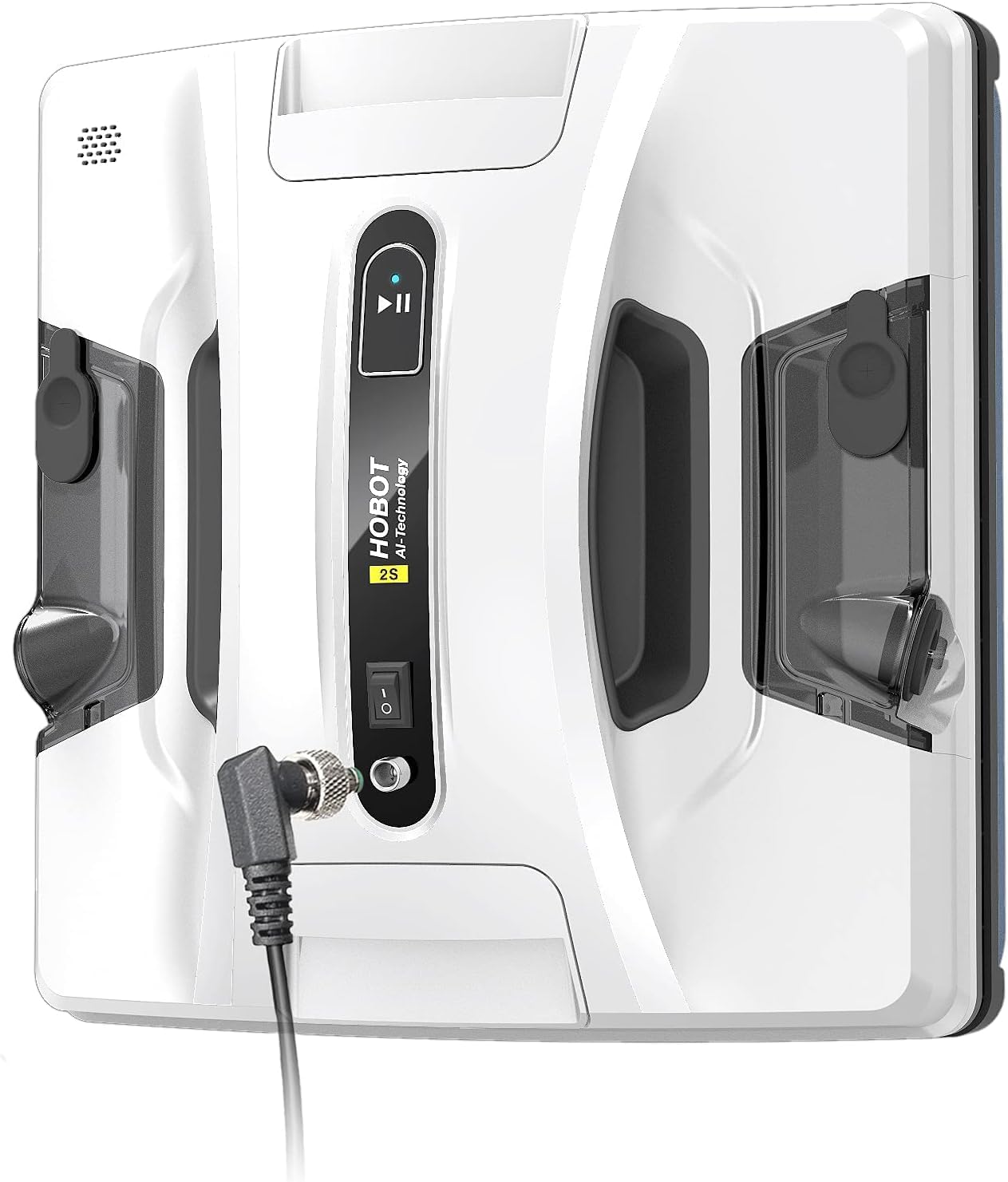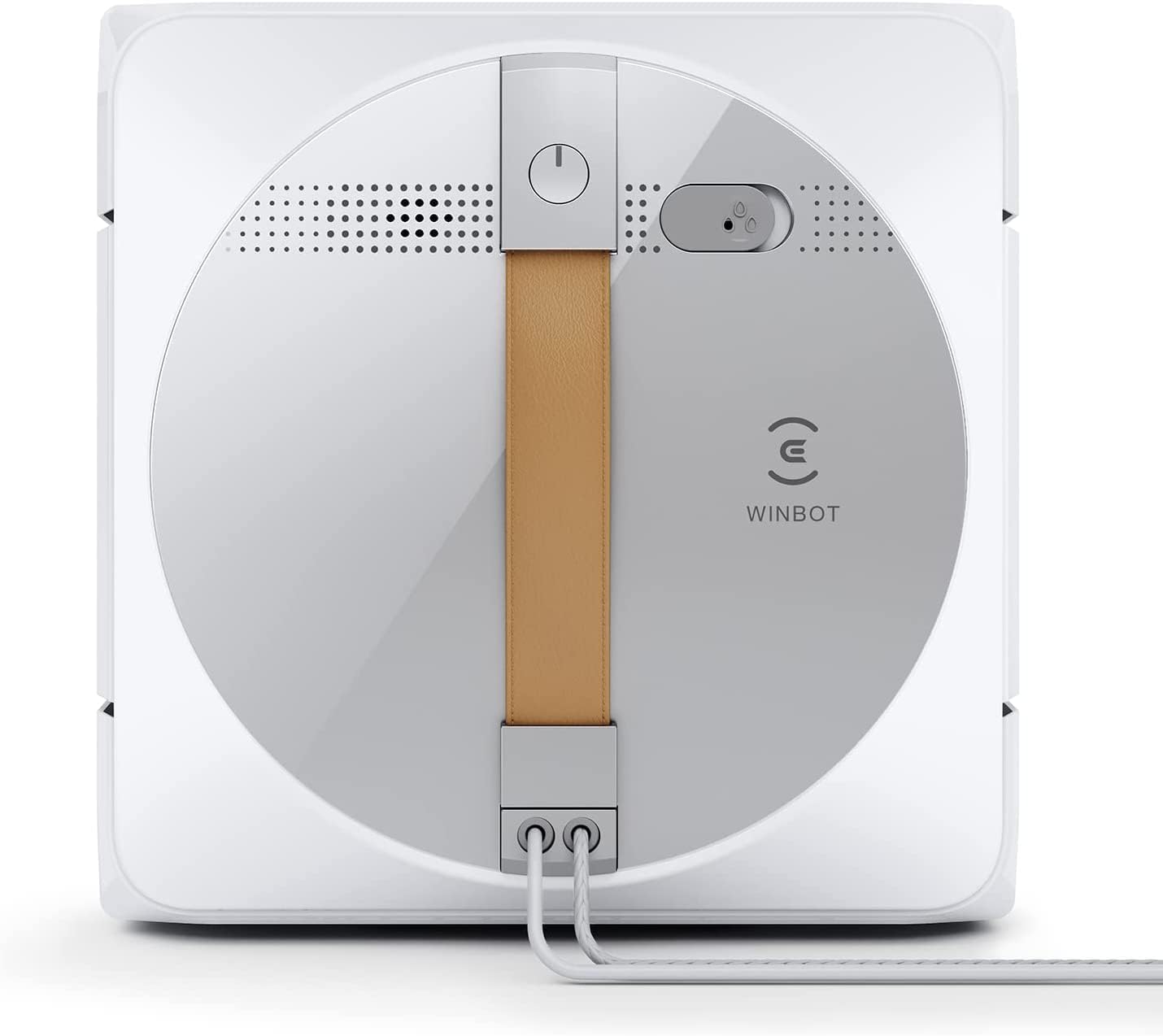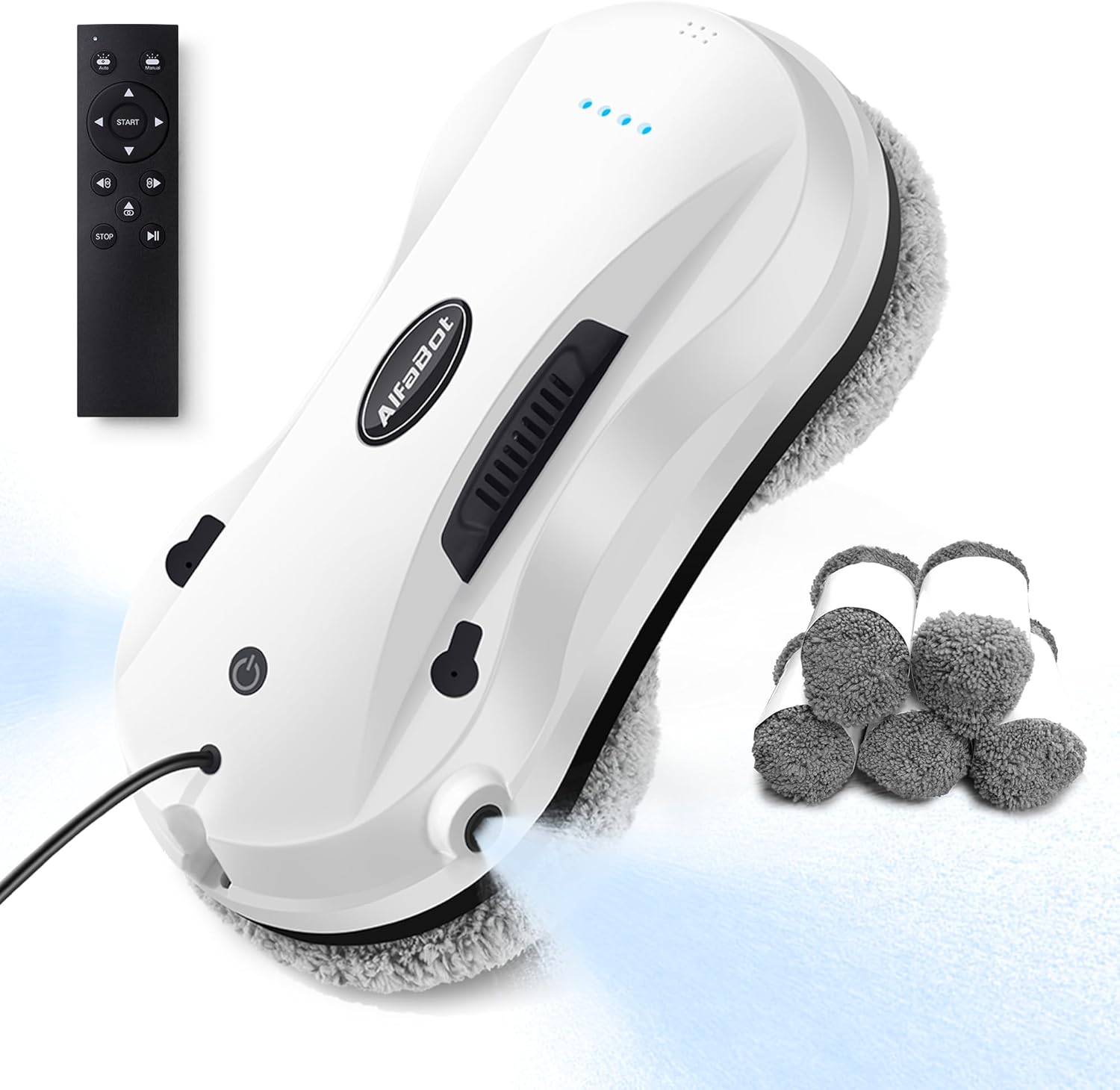How They Work: Suction, Navigation, and Safety
Robot window cleaners might seem like simple machines at first glance, but under the hood, they combine smart engineering and clever algorithms to make glass cleaning efficient, hands-free, and surprisingly reliable. Understanding how they function can help you pick the right model—and use it more effectively.
Let’s break their inner workings down into three main components: Suction, Navigation, and Safety.
1. Suction Power (or Magnetic Adhesion): How They Stay on the Glass
The first question most people ask is: How does it not fall off?
The answer lies in two main technologies used to keep robot window cleaners attached to vertical surfaces:
A. Vacuum Suction Technology (Most Common in 2025 Models)
Modern robot window cleaners primarily use high-speed vacuum motors that create negative air pressure. This pressure forms a seal between the robot and the glass surface, allowing the cleaner to cling vertically—even on completely smooth, frameless windows.
How it works: As the vacuum fan spins, it pulls air out from between the cleaner and the glass. The resulting low-pressure area sucks the device tightly to the window.
Power requirement: These motors require a continuous power source to maintain suction, which is why most models need to be plugged into a wall socket or power bank during use.
Cleaning compatibility: Works best on flat, smooth surfaces like windows, glass doors, and large mirrors.
B. Magnetic Adhesion Technology (Used in Dual-Sided Models)
Some older or specialty models use strong neodymium magnets instead of vacuum suction. These robots have two parts—one placed on the inside of the glass, the other on the outside—and the magnets hold them together through the windowpane.
Advantage: Allows for simultaneous cleaning of both sides of the glass.
Downside: Limited to specific window thicknesses and may be harder to set up.
In 2025, vacuum suction is by far the most popular and flexible method, especially for exterior cleaning on high-rise apartments and commercial buildings.
2. Navigation: How They Know Where to Go (and What Not to Hit)
Cleaning windows isn’t just about sticking to the glass—it’s about moving intelligently to cover the entire surface without missing spots or getting stuck in corners. This is where navigation systems come into play.
Modern robot window cleaners use a combination of smart sensors and algorithms to plan their path, adjust direction, and detect edges. Here’s how:
A. AI-Powered Route Planning
Most mid-to-high-end robots in 2025 are equipped with microprocessors that control the cleaning pattern.
Zigzag or N-pattern cleaning: These patterns help cover the entire surface without overlapping or missing areas.
Memory mapping: Some advanced models remember where they’ve already cleaned, allowing them to resume if interrupted (e.g., by a power outage).
Custom route options: With app-controlled robots, users can sometimes set custom cleaning zones or direct the robot with a remote.
B. Edge Detection Sensors
What happens when the robot reaches the edge of a frameless window? Thanks to high-precision infrared or laser sensors, the robot can detect when it’s nearing an edge and slow down or reverse course.
Important for: Frameless windows, glass railings, and mirrors.
Works in real time: The robot adjusts its trajectory within milliseconds to avoid falling.
C. Obstacle Detection and Adjustment
Some window surfaces may have stickers, frames, or textured sections. Robots equipped with obstacle detection can sense these irregularities and adjust their path.
Types of sensors used: IR sensors, gyroscopes, accelerometers, and even pressure sensors on the cleaning pads.
New in 2025: A few premium models now feature machine learning capabilities that “learn” the layout of your windows over time for even better efficiency.
3. Safety Features: Preventing Falls, Failures, and Frustration
Window cleaning robots often work in risky environments—high up, outdoors, and often unattended. So safety mechanisms are built into every modern model to prevent accidents or damage.
A. Anti-Fall Algorithms
Using a combination of sensors and real-time monitoring, robots can detect any drop in suction or abnormal tilt.
If suction weakens, the robot immediately stops moving and emits an audible alarm.
Some models engage an emergency braking mechanism to minimize risk while still attached to the surface.
B. Backup Battery (Uninterruptible Power Supply – UPS)
Most robot window cleaners come with an internal lithium-ion battery that kicks in if the main power supply is interrupted.
Runtime: Typically lasts 20–30 minutes—enough time for you to safely retrieve the robot.
Peace of mind: Essential for high-rise use where a fall could be dangerous or costly.
C. Safety Tether/Cord
Every robot cleaner includes a safety rope (usually around 4–6 meters long) with a carabiner or suction cup to attach to a secure point.
Acts as a physical fail-safe in case all electronic systems fail.
Recommendation: Always use the tether—even if you’re cleaning low windows. It’s a simple precaution that can prevent damage or injury.
D. Manual Override and Alerts
Many models come with remote controls or smartphone apps that allow you to:
Pause the cleaning
Redirect or restart the cleaning path
Monitor battery life and suction strength
Get real-time alerts in case of issues
In 2025, app connectivity is practically a standard feature, making the robot cleaner experience more interactive and safe.
In Summary: How It All Comes Together
Here’s a quick recap of the robot cleaner’s workflow:
Sticks to the glass using vacuum suction or magnets
Scans the window surface with sensors and plans a path
Cleans in a methodical pattern with microfiber pads and, optionally, a water spray
Monitors its own performance to ensure suction is stable
Uses backup systems to stay safe in case of failure
With these systems working in harmony, today’s robot window cleaners can confidently tackle most glass surfaces—indoors and out, high or low. The better you understand their technology, the more effectively you can use them to keep your windows sparkling clean without lifting a finger.
Manual vs. Robot: Which Cleans Better?
If you’re debating whether a robot window cleaner can truly replace the old-school method of manual cleaning, you’re not alone. It’s a valid question—and the answer depends on several factors, including the type of dirt, window accessibility, cleaning frequency, and user expectations.
Let’s break down the pros and cons of each method to help you decide which is better suited for your needs.
Manual Window Cleaning: The Gold Standard for Deep Cleaning
Manual window cleaning—whether done by hand, with a squeegee, microfiber cloth, or a professional service—has been the go-to method for decades. It offers complete control and allows you to adjust your approach based on dirt type, window shape, and surrounding frames.
✅ Pros of Manual Cleaning:
Precision: You can target stubborn spots, edges, and corners with more accuracy.
Flexibility: Works well on oddly shaped windows, curved glass, skylights, and textured surfaces.
Thoroughness: Manual cleaning allows for pressure application, ensuring removal of hardened stains like bird droppings, pollen, or grease.
Framing & Detailing: You can also clean window sills, tracks, and ledges—areas robots usually miss.
❌ Cons of Manual Cleaning:
Labor-intensive: Requires time, energy, and often ladders for hard-to-reach windows.
Inconsistent results: Streaks, smudges, or missed spots are common without proper technique or tools.
Safety risks: Cleaning high or exterior windows can be dangerous, especially for older adults or buildings above the ground floor.
Mess potential: Water can drip onto floors or furniture if you’re not careful.
Robot Window Cleaners: The Smart Way to Stay Clean
Robot window cleaners are all about convenience and consistency. They’re ideal for maintenance cleaning and covering large, flat glass surfaces quickly and with minimal effort.
While they might not yet match the precision of human hands for heavy-duty dirt, they excel in routine upkeep, especially in homes with lots of glass or hard-to-reach windows.
✅ Pros of Robot Cleaning:
Hands-free operation: Just press start and let it do the work while you relax, work, or do other tasks.
Consistent results: Robots follow programmed patterns, ensuring even coverage without random missed spots.
Safe for high windows: No more ladders or risky maneuvers—robots can clean tall, exterior glass safely with suction and safety tethers.
Time-saving: Great for large homes, high-rise apartments, or glass-heavy office spaces.
Energy-efficient: Uses minimal power and can often be charged via standard outlets or power banks.
❌ Cons of Robot Cleaning:
May miss stubborn grime: Requires pre-cleaning or touch-ups on heavily soiled windows.
Edge and frame limitations: Corners, edges, and window frames may still need manual attention.
Pad maintenance: Dirty pads reduce cleaning efficiency and must be cleaned or replaced regularly.
Setup time: You’ll need to position the device correctly, plug it in, attach the safety rope, and occasionally intervene.
Noise: Although quieter than vacuums, the suction motor does emit a noticeable hum.
Cleaning Performance Comparison Table
| Feature | Manual Cleaning | Robot Window Cleaner |
|---|---|---|
| Cleaning Quality | High (especially for grime) | Moderate to High (for maintenance) |
| Ease of Use | Requires effort & skill | Very easy – set and go |
| Speed (for large areas) | Slow to moderate | Fast and efficient |
| Safety (for high places) | Risky | Very safe with tether |
| Access to corners & edges | Excellent | Limited |
| Streak Removal | Excellent with skill | Good with clean pads |
| Requires Setup or Equipment | Yes | Yes, but minimal |
| Can clean frames/sills | Yes | No |
| Ongoing Maintenance | Occasional (tools) | Regular (pads, charging) |
When Manual Wins: Best-Use Scenarios
Deep seasonal cleaning: Ideal for tackling winter grime, dust buildup, or post-construction dirt.
Textured or frosted glass: Robots rely on suction, which can be less effective on irregular surfaces.
Small windows or decorative panes: Manual is quicker and easier for detailed, intricate work.
First-time cleaning: If a window hasn’t been cleaned in a while, manual cleaning can prepare the surface for ongoing robot use.
When Robots Win: Best-Use Scenarios
Routine maintenance: Set a regular schedule for your robot to keep windows spotless year-round.
Tall or hard-to-reach windows: Avoid climbing ladders or hiring pros.
Busy lifestyles: Let the robot multitask with you—it works while you do something else.
Large glass surfaces: Perfect for sliding doors, glass walls, balconies, and sunrooms.
A Hybrid Approach: The Smartest Solution?
Many homeowners and office managers are discovering that a hybrid approach delivers the best results:
Use manual cleaning for deep cleans, touch-ups, and small or irregular windows.
Let the robot handle weekly or bi-weekly maintenance on large, flat surfaces.
This combo ensures your windows are always clear without spending your weekends climbing ladders or chasing streaks.
Before using a robot cleaner for the first time, give your windows a thorough manual cleaning. This helps the robot glide more easily, avoids pad saturation from built-up dirt, and leads to better long-term results.
Which Cleans Better?
If you demand spotless perfection or are dealing with thick grime, manual cleaning is still the gold standard. But if your windows just need regular upkeep and you want to save time (and your back), a robot cleaner is a worthy ally—especially in combination with periodic manual touch-ups.
In short:
Manual = best for precision and deep cleaning
Robot = best for convenience, safety, and maintenance
Together, they make an unbeatable team for sparkling, hassle-free windows.




